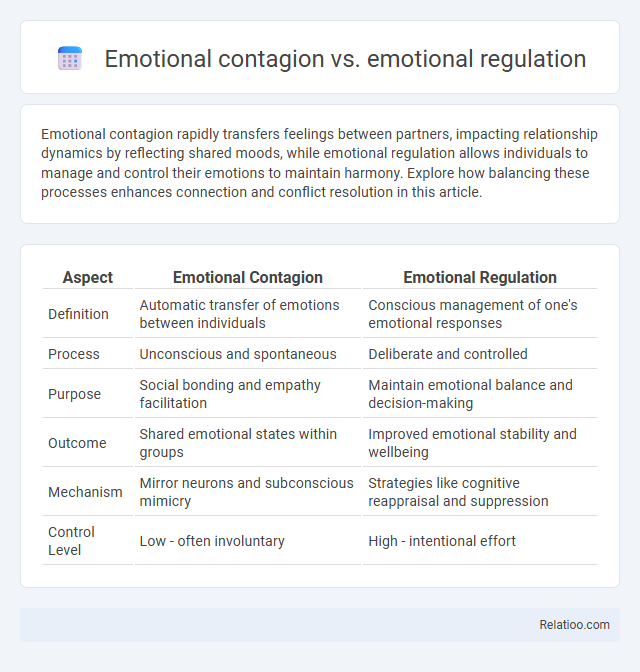Emotional contagion rapidly transfers feelings between partners, impacting relationship dynamics by reflecting shared moods, while emotional regulation allows individuals to manage and control their emotions to maintain harmony. Explore how balancing these processes enhances connection and conflict resolution in this article.
Table of Comparison
| Aspect | Emotional Contagion | Emotional Regulation |
|---|---|---|
| Definition | Automatic transfer of emotions between individuals | Conscious management of one's emotional responses |
| Process | Unconscious and spontaneous | Deliberate and controlled |
| Purpose | Social bonding and empathy facilitation | Maintain emotional balance and decision-making |
| Outcome | Shared emotional states within groups | Improved emotional stability and wellbeing |
| Mechanism | Mirror neurons and subconscious mimicry | Strategies like cognitive reappraisal and suppression |
| Control Level | Low - often involuntary | High - intentional effort |
Understanding Emotional Contagion: Definition and Mechanisms
Emotional contagion refers to the automatic process by which emotions are transferred from one person to another through facial expressions, vocal tone, and body language, influencing group dynamics and social interactions. Emotions spread unconsciously within social networks, impacting your mood and decision-making without deliberate control. Understanding this mechanism highlights the importance of emotional regulation, which involves consciously managing your emotional responses to maintain psychological balance and interpersonal harmony.
What Is Emotional Regulation? Key Concepts Explained
Emotional regulation involves managing and modifying your emotional responses to achieve desired outcomes, crucial for mental well-being and effective decision-making. Unlike emotional contagion, where feelings are automatically transferred between individuals, emotional regulation requires conscious effort to control or adjust emotions. Understanding key concepts like cognitive reappraisal and expressive suppression helps you develop strategies to maintain emotional balance and resilience.
Emotional Contagion vs Emotional Regulation: Fundamental Differences
Emotional contagion involves the automatic transfer of emotions from one person to another, often occurring unconsciously and influencing group dynamics and social interactions. Emotional regulation, by contrast, refers to the deliberate process of managing and modulating one's emotional responses to achieve adaptive outcomes and maintain psychological well-being. The fundamental difference lies in emotional contagion's passive, involuntary nature versus emotional regulation's active, intentional control over emotional experiences.
The Science Behind Emotional Contagion and Regulation
Emotional contagion involves the automatic spread of emotions from one person to another through neural mirroring and subconscious mimicry, impacting your mood and social interactions. Emotional regulation, on the other hand, engages prefrontal cortex mechanisms to consciously control and modulate emotional responses, thereby influencing psychological resilience and decision-making. Understanding the neuroscience of these processes reveals how you can harness emotional contagion for social bonding while applying regulation techniques to maintain emotional balance.
Real-World Examples: How Emotional Contagion and Regulation Manifest
Emotional contagion occurs when individuals unconsciously mimic the emotions of those around them, such as employees catching anxiety during a high-stress meeting, leading to a collective mood shift. In contrast, emotional regulation involves consciously managing and modulating one's emotional responses, as seen in customer service representatives maintaining calm and empathy despite confronting upset clients. Real-world scenarios like healthcare teams balancing compassionate engagement with emotional detachment highlight the interplay between emotional contagion and regulation for effective interpersonal dynamics.
Impacts on Relationships: From Empathy to Conflict
Emotional contagion, the automatic sharing of emotions, can enhance empathy and strengthen Your relationships by creating a shared emotional experience. Emotional regulation involves consciously managing emotions to respond appropriately, reducing the likelihood of conflict and promoting healthier interactions. Understanding these dynamics helps prevent emotional contagion from escalating into misunderstandings or tensions within relationships.
Emotional Contagion in the Workplace: Benefits and Risks
Emotional contagion in the workplace refers to the phenomenon where employees unconsciously mimic and absorb emotions from their colleagues, significantly influencing team dynamics and overall morale. Benefits include enhanced empathy, improved collaboration, and increased motivation, while risks involve the rapid spread of negative emotions such as stress or frustration, potentially harming productivity and workplace culture. Balancing emotional contagion with emotional regulation strategies helps organizations foster a positive environment while mitigating the adverse effects of negative emotional transmission.
Strategies for Effective Emotional Regulation
Strategies for effective emotional regulation include mindfulness techniques, cognitive reappraisal, and stress management practices that help you recognize and modify emotional responses. Emotional contagion, the automatic transfer of emotions between individuals, can be mitigated by enhancing self-awareness and practicing controlled breathing to maintain composure in social interactions. Prioritizing emotional regulation fosters better mental health, improved decision-making, and stronger interpersonal relationships.
Emotional Intelligence: Balancing Contagion and Regulation
Emotional intelligence involves mastering the balance between emotional contagion, which allows you to empathize and connect by absorbing others' feelings, and emotional regulation, which empowers you to manage and respond to these emotions effectively. Your ability to discern when to embrace or control emotional contagion enhances interpersonal relationships and decision-making skills. This dynamic interplay is essential for maintaining emotional well-being and fostering productive social interactions.
Building Resilience: Cultivating Healthy Emotional Responses
Building resilience involves understanding emotional contagion, where moods and feelings can spread between people, affecting group dynamics and individual well-being. Effective emotional regulation empowers you to manage your responses, reducing the impact of negative emotional contagion and enhancing your capacity to stay calm and focused under stress. Cultivating healthy emotional responses creates a balanced mental state, promoting resilience by allowing adaptive reactions to challenges rather than automatic emotional mimicry.

Infographic: Emotional contagion vs Emotional regulation
 relatioo.com
relatioo.com